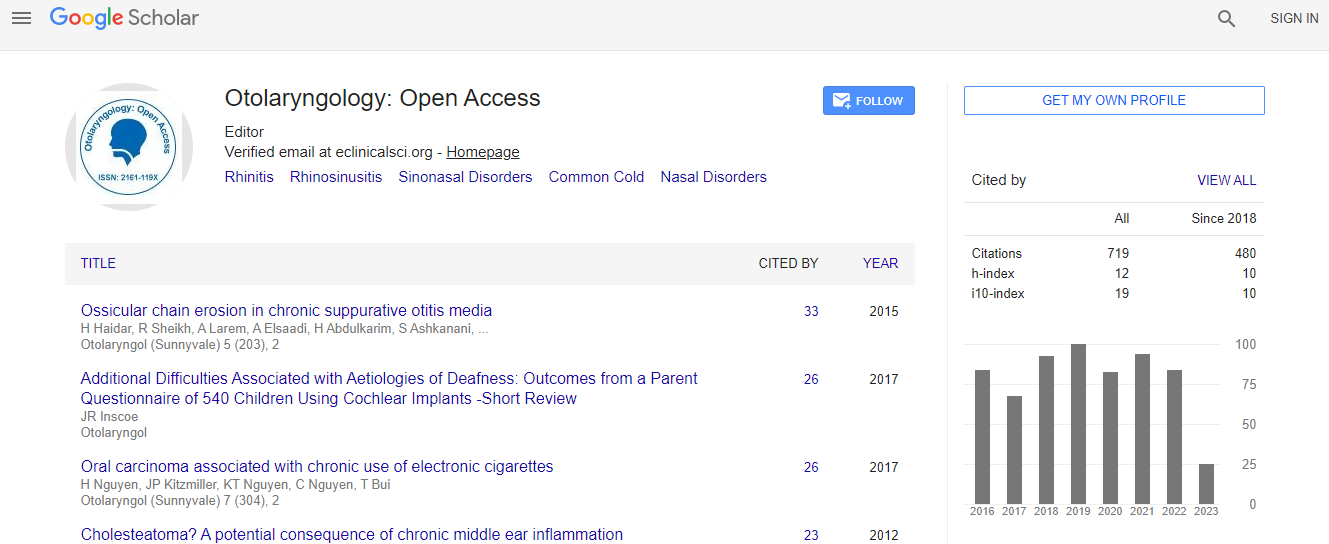Our Group organises 3000+ Global Conferenceseries Events every year across USA, Europe & Asia with support from 1000 more scientific Societies and Publishes 700+ Open Access Journals which contains over 50000 eminent personalities, reputed scientists as editorial board members.
Open Access Journals gaining more Readers and Citations
700 Journals and 15,000,000 Readers Each Journal is getting 25,000+ Readers
Google Scholar citation report
Citations : 925
Otolaryngology: Open Access received 925 citations as per Google Scholar report
Otolaryngology: Open Access peer review process verified at publons
Indexed In
- Index Copernicus
- Google Scholar
- Sherpa Romeo
- Open J Gate
- Genamics JournalSeek
- RefSeek
- Hamdard University
- EBSCO A-Z
- OCLC- WorldCat
- Publons
- Geneva Foundation for Medical Education and Research
- ICMJE
Useful Links
Recommended Journals
Related Subjects
Share This Page
Evolutions in robotic microlaryngeal surgery
5th Global Summit and Expo on Head, Neck and Plastic Surgery
Lee M Akst
Johns Hopkins University, USA Johns Hopkins Voice Center, USA
ScientificTracks Abstracts: Otolaryngol (Sunnyvale)
Abstract
This presentation will review limitations of current robotic approaches to microlaryngoscopy and will introduce the audience to a new robotic technology with the potential to change how microlaryngeal surgeries are performed. The evolution of laryngeal surgical techniques has been driven by the promise of increased operative precision. Coincident with advances in microlaryngeal surgery have been similar, though more rapid, advances in robot-assisted surgery within otolaryngology. From well-established use of the da Vinci surgical robot for ablative procedures of the pharynx to newer applications for robot-assisted procedures such as thyroid surgery and skull base surgery, robotic-assisted surgery is growing. Despite these advances, robot-assisted surgery is not yet routinely incorporated into microlaryngeal surgery. Current limitations for existing commercial systems include: Size of available instrumentation, difficulty manipulating robotic effector arms within narrow working space afforded by standard retractors and reduced haptic feedback that comes from working remotely rather than handling tissues directly. Even as smaller instruments and new retractors are being developed, existing robots have been largely limited to laryngeal procedures such as vocal cord stripping, cordectomy and partial epiglottectomy procedures in which preservation of normal vocal fold anatomy and function are not prioritized. To address these issues and create a role for robotic assistance in microlaryngoscopy; a novel robotic ENT microsurgery system (REMS) has been developed. This system emphasizes cooperative control, rather than remote control, of a microsurgical instrument; traditional microlaryngoscopy instruments are utilized with both the robot arm and surgeon controlling the same instrument. The ability of this REMS system to improve precise performance of simulated microlaryngoscopy tasks has been demonstrated in a variety of research studies. These preliminary studies, their methods and their results will be reviewed; surgical videos will demonstrate the robot �in action�. The REMS platform may represent the next step in the evolution of robotic microlaryngeal surgery.Biography
Lee M Akst is the Head of the Johns Hopkins Voice Center and is the Director of the Division of Laryngology at the Johns Hopkins University, Department of Otolaryngology- Head and Neck Surgery. The focus of his clinical practice is on management of voice disorders with focus on office-based treatments and operative management of epithelial diseases such as vocal cord leukoplakia, papilloma and early glottis cancer. He has lectured extensively on phonosurgical techniques, treatment of laryngeal leukoplakia, laryngopharyngeal reflux and globus pharyngeus. He has been working with engineers at Johns Hopkins on novel robotic platforms to bringing robotic surgery into the endolarynx to aid microlaryngeal operative precision. He has received his undergraduate and medical degrees from Yale University, did his Otolaryngology Residency at the Cleveland Clinic and completed his Laryngology Fellowship at Massachusetts General Hospital.
Email: LAKST1@jhmi.edu

 Spanish
Spanish  Chinese
Chinese  Russian
Russian  German
German  French
French  Japanese
Japanese  Portuguese
Portuguese  Hindi
Hindi 
